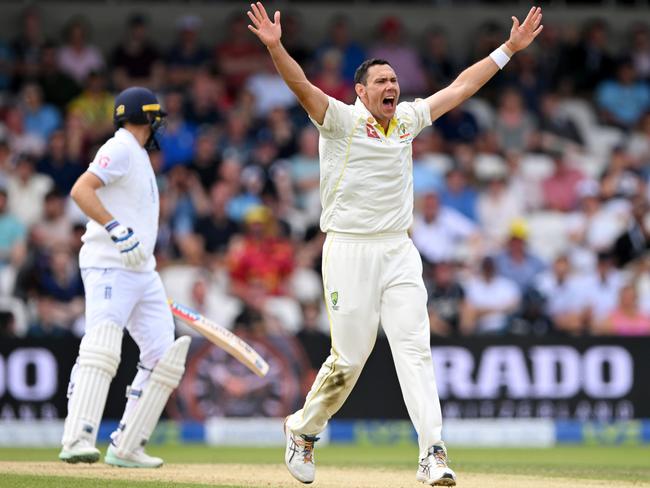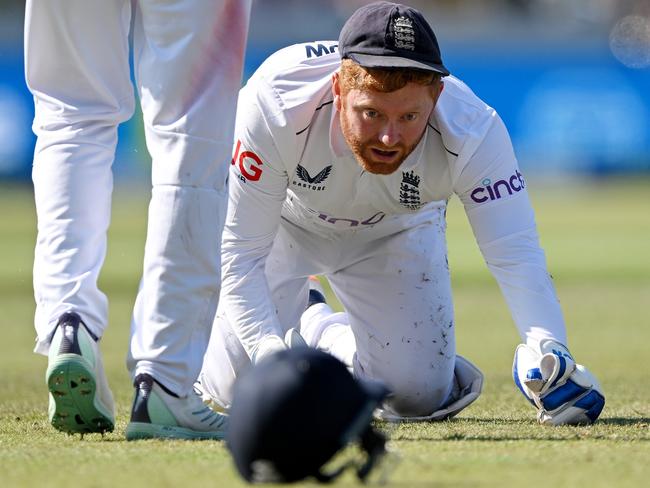Mike Atherton: Aussie cracks starting to open as changes loom for fourth Ashes Test
At least one change is looming for Australia in the fourth Ashes Test amid a raft of selection headaches, while England has a difficult situation of its own, writes MIKE ATHERTON.

Ashes
Don't miss out on the headlines from Ashes. Followed categories will be added to My News.
“So we beat on … borne back ceaselessly into the past.” With apologies to F. Scott Fitzgerald, there are historical echoes everywhere in this series. Four years ago, after Ben Stokes inspired a thrilling comeback in the third Test at Headingley, England and Australia contemplated a nine-day break before the start of the fourth Test at Old Trafford, just like now.
After three absorbing games – themselves resonant of the three central games of the 2005 series, with tight margins placing a premium on every session – the players (and supporters and, dare it be said, journalists) will welcome a chance to recharge the batteries. Modern schedules rarely allow for anticipation, but this break bucks the trend and Old Trafford will be better for it.
Justin Langer, Australia’s coach in 2019, described that hiatus as the most challenging but ultimately rewarding of his post-playing career as he tried to engineer a response from his players. His successor, Andrew McDonald, has a similar task now to lift his team after a galling defeat.
The day after the defeat at Headingley four years ago, Langer made the decision to cancel leave for those not involved in the county game at Derbyshire. He wanted his entire squad to stay together, an unpopular move for those who were planning a few days in London. Equally unpopular was the decision to force the players to watch the last hour of that game again. Peter Siddle and Nathan Lyon kicked up a fuss, but watched nonetheless.
Langer recalled that the strength of feeling could be seen in the pre-match warm-up before the Derbyshire game, where his players flew into each other during their knockabout game of Aussie rules. There is no county game in this particular interlude and Australia’s players will stick to their planned break before reconnecting next weekend in Manchester.

Given the intensity of the cricket, optional time away sounds a very sensible decision. Five-day cricket is a challenge for body and mind – the former for bowlers, the latter for batsmen – and Australia have effectively played four consecutive Tests now owing to their World Test Championship final against India. The European mainland is on the radar for some; Scotland and the Cotswolds for others. Those wanting culture have opted for Manchester (obviously).
McDonald has some thinking to do in that time because some cracks have started to open. David Warner’s travails against Stuart Broad are obvious: Broad has now dismissed him 17 times in all, and a further three times for low scores in this series. Warner has looked in decent touch in the main, but there were signs at Headingley that he had begun to tinker with his set-up and technique, much as he had in 2019 when things got worse as the series progressed.
What should they do? Warner’s form is a concern, but his possible replacements, Marcus Harris and Matt Renshaw, have had little cricket. Neither is exceptional in the field, whereas Warner’s slip catching has been of its usual high standard; given the quality of Australia’s fast bowling, good slip fielding remains an underappreciated asset. Warner’s body language remains strong and he looks up for the contest. They should stick with him.

Scott Boland is another concern, having taken only two wickets in two Tests and leaking runs at a rate. Boland’s strength is his ability to bowl long economical spells but England have refused to allow that to happen, batting proactively against him by using their feet and disrupting his length. His economy rate thus far is 4.91. Josh Hazlewood will return in place of him.
But none of Mitchell Starc, Pat Cummins or Hazlewood are workhorses, which brings into focus the two other worrying strands for Australia: Todd Murphy and Cameron Green. Lyon’s ability to bowl in all conditions, from days one to five, allowed Australia the luxury of playing three main seamers and Green as an all-rounder, even with a limit on the workload.
Judging from the way Cummins was reluctant to use Murphy on the decisive fourth day – the off spinner bowled only two overs – they no longer have that luxury.
With Lyon relied on to bowl no matter the conditions, Australia did not have to worry about the balance of their side, the presence of an all-rounder being a bonus. England, too, have that problem now that Stokes’s body has effectively made him a batting captain in all but extreme or emergency situations. That was why England wanted to play five frontline bowlers in Leeds and why Chris Woakes had to play because of his batting.

It is likely that England will seek the same balance at Old Trafford, with four frontline seamers, plus Moeen Ali. Mark Wood and Stuart Broad are certainties on form; Woakes plays for his all-round ability, which leaves one seamer from Josh Tongue, Ollie Robinson and James Anderson. Suddenly, Anderson’s position looks uncertain, although his knowledge of home conditions gives him the edge.
But it still leaves the problem of No 3, because Joe Root, Harry Brook, Jonny Bairstow and Stokes are all more comfortable at Nos 4, 5 and 6. The experiment with Ali was all about protecting Brook at No 5, but Stokes intimated after the match that it is unlikely to be continued. It is still hard to see past the logic of Root at No 3, as the best player in the team and the one likeliest to act as a buffer for those below.
That balance of the team also impacts upon the wicketkeeping debate. To play five bowlers, the wicketkeeper has to bat in the top six. Readers of The Times have been (by and large) fulminating about Bairstow’s wicketkeeping and about the continued omission of Ben Foakes. It is true that Bairstow has looked rusty and not the ‘keeper of five years ago when he was doing the job full time.
It is a very tricky debate, though, and unless they go with Root as a solitary spinner (risky at Old Trafford), the wicketkeeper will have to bat in the top six, which plays to Bairstow’s advantage. The squad will be picked towards the end of the week and then, with apologies to the great writer again, will get a chance to reconnect in Manchester with “the pursued, the pursuing, the busy and the tired”. Thankfully, maybe a little less tired by next Wednesday.
More Coverage
Originally published as Mike Atherton: Aussie cracks starting to open as changes loom for fourth Ashes Test





